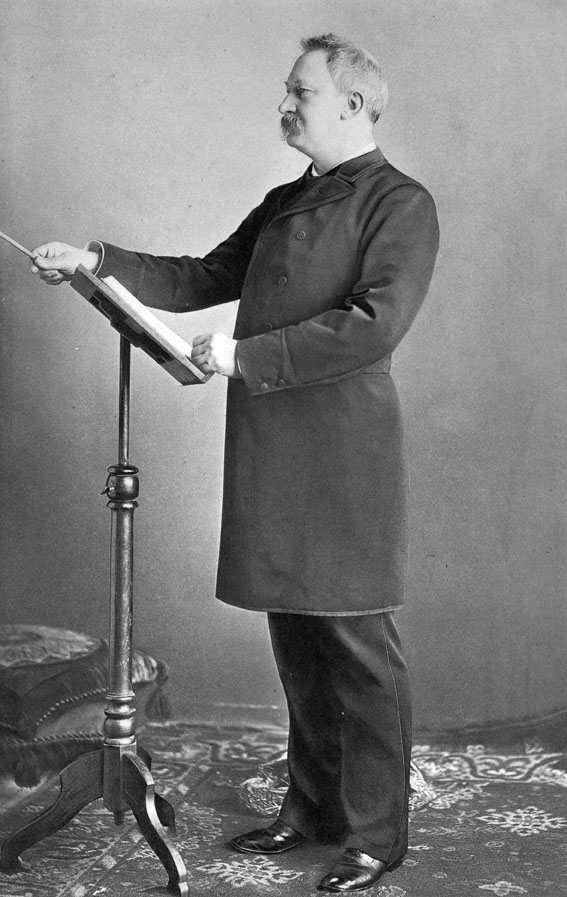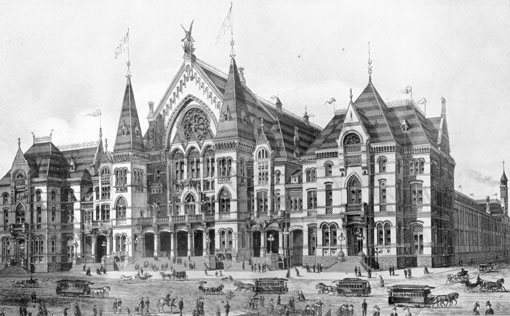By Lauren Fink
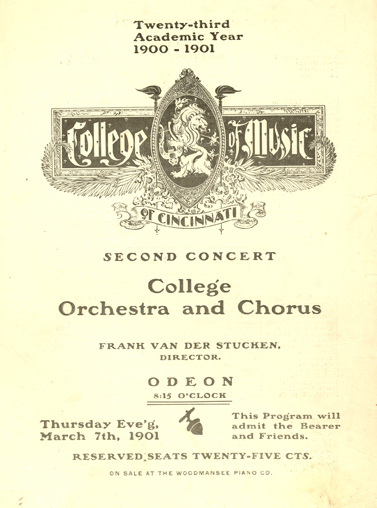 In the Archives and Rare Books Library, we recently processed a collection containing historical records of the College of Music of Cincinnati. This collection spans 1878-1967 and contains commencement bulletins, programs, student rosters, and minutes of executive, financial, and stockholder’s committee meetings. Illustrating the historical and biographical nature of this collection, the 1926 commencement bulletin entitled “College Comments,” contains articles on the College’s faculty, graduating students, clubs, and ensembles. Further, meeting minutes provide details of all of the College’s major educational and financial concerns and
In the Archives and Rare Books Library, we recently processed a collection containing historical records of the College of Music of Cincinnati. This collection spans 1878-1967 and contains commencement bulletins, programs, student rosters, and minutes of executive, financial, and stockholder’s committee meetings. Illustrating the historical and biographical nature of this collection, the 1926 commencement bulletin entitled “College Comments,” contains articles on the College’s faculty, graduating students, clubs, and ensembles. Further, meeting minutes provide details of all of the College’s major educational and financial concerns and 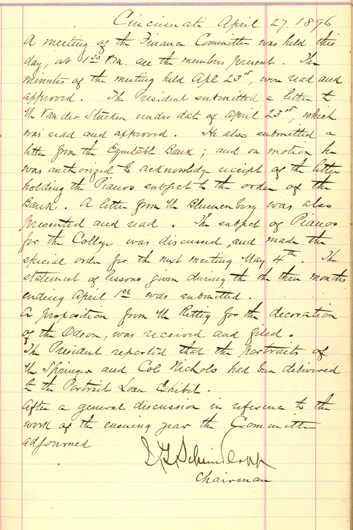 decisions, such as how to create more space for radio labs or the necessity of hiring certain faculty for certain departments. The minutes also contain outlines of correspondence between the College and the Conservatory of Music on having a connection with each other. To view the contents of this new collection, see the finding aid online (http://rave.ohiolink.edu/archives/ead/OhCiUAR0287).
decisions, such as how to create more space for radio labs or the necessity of hiring certain faculty for certain departments. The minutes also contain outlines of correspondence between the College and the Conservatory of Music on having a connection with each other. To view the contents of this new collection, see the finding aid online (http://rave.ohiolink.edu/archives/ead/OhCiUAR0287).
After browsing this collection, I was intrigued to learn more about CCM’s rich history. Though students at the College-Conservatory of Music (CCM) are aware of the merger of two fine institutions because of CCM’s hyphenated name, rarely is this history discussed. As a percussion student at the College-Conservatory, every day I walk past names like Baur, Gorno, Watson, Werner, and Corbett which grace the school’s walls, recital halls, and master classrooms. However, until I started working at the Archives and Rare Books Library, I had no idea that these names I pass daily are testaments to the history of both the merger of the College of Music of Cincinnati with the Cincinnati Conservatory of Music (to form CCM) as well as the merger of CCM and the University of Cincinnati.
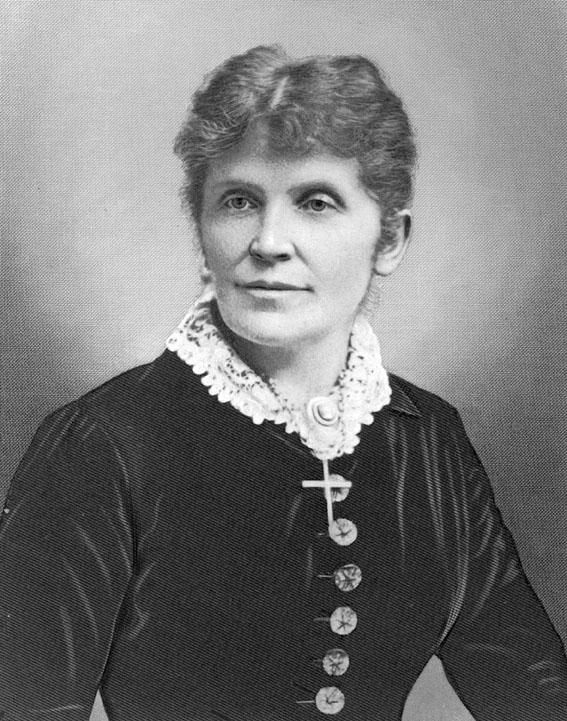 The Cincinnati Conservatory of Music was founded in 1867 by Clara Baur, a native German who studied at the Stuttgart Conservatory but moved to Cincinnati at age 13 to live with her brothers. The initial conservatory was located on Eighth and Vine Streets and later another building was established at 139 West Eighth Street. Still later, the Conservatory moved to a mansion at Fourth and Lawrence, and eventually in 1902, the Conservatory moved out of the city basin to the former Shillito mansion in Mt. Auburn. When Clara Baur died in 1912, her niece Bertha assumed all Conservatory responsibilities. Though Bertha was a capable, beloved leader for many years, in 1930, financial hardship was a catalyst to Bertha’s conveying the Conservatory to the Cincinnati Institute of Fine Arts. Bertha still continued to serve as president emeritus until 1940 when she died.
The Cincinnati Conservatory of Music was founded in 1867 by Clara Baur, a native German who studied at the Stuttgart Conservatory but moved to Cincinnati at age 13 to live with her brothers. The initial conservatory was located on Eighth and Vine Streets and later another building was established at 139 West Eighth Street. Still later, the Conservatory moved to a mansion at Fourth and Lawrence, and eventually in 1902, the Conservatory moved out of the city basin to the former Shillito mansion in Mt. Auburn. When Clara Baur died in 1912, her niece Bertha assumed all Conservatory responsibilities. Though Bertha was a capable, beloved leader for many years, in 1930, financial hardship was a catalyst to Bertha’s conveying the Conservatory to the Cincinnati Institute of Fine Arts. Bertha still continued to serve as president emeritus until 1940 when she died.
Cincinnati’s other major music school, the College of Music, was founded in 1878 by Cincinnatian George Ward Nichols. Theodore Thomas, a renowned musician and conductor, became the College’s music director, with much of his and the institution’s funding provided by Reuben Springer, a wealthy Cincinnati businessman and philanthropist. The College of Music was located in Dexter Hall, a part of Cincinnati’s Music Hall. Later, it moved to a permanent location known as the Odeon, and eventually it consisted of multiple buildings in Over-the-Rhine, connected to Music Hall.
The College, as well as the Conservatory, had outstanding faculty. For instance, Albino Gorno, who is the namesake of CCM’s Music Library, was on the piano faculty at the College for sixty years. Other notable College faculty included Frank Van der Strucken, Adolph Hahn, Lotte Leonard, Otte Singer, Umberto Neely, William H. Albers, and Henry E. Krehbiel. However, even with such great faculty, internal management conflicts as well as financial deficits eventually made the College’s merger with the Conservatory inevitable.
The long-anticipated merger of the Conservatory and the College has been likened by writer B.J. Foreman as a “courtship between two lovers.” In her analysis of the history between the two, Foreman proposes the analogy that the Conservatory was feminine, run by the Baur women who offered classes on elocution and social graces, and had dormitory rules involving dress codes and chaperones both on and off campus. The College was masculine, run like a business with cutting edge technology such as radio broadcasting. Foreman, whose history of CCM can be found in the Archives and Rare Books Library (Spec Col Ref MT 4 .C5 C57 1992), declares that the two institutions finally came together in 1955 as an “old lady” and “old gentleman” in a “marriage of convenience.” The College moved to the Conservatory campus, with radio and television academic programs remaining in its downtown location.
However, financial and accreditation problems persisted. The merger of the College and the Conservatory was not enough to save both institutions. Hence, in 1962 the College-Conservatory of Music was absorbed by the University of Cincinnati, which had long-standing academic partnerships with it. At first, CCM departments were scattered across campus wherever space was available. When Jack Watson, a Conservatory graduate and accomplished actor and singer, became dean of the Conservatory, he was able to fundraise among his Cincinnati connections. With the help of J. Ralph and Patricia Corbett, CCM found a new home in Mary Emery Hall and the Corbett Center for the Performing Arts which opened in 1967. The Patricia Corbett Pavilion was built in 1972. Later, under the deanship of Robert Werner, CCM’s status was elevated by the help of donors like Louise Nippert, who funded endowed chairs which allowed for even more world-renowned artists to join CCM’s already outstanding faculty.
Today, CCM continues to flourish. Undoubtedly, recently-appointed dean, Peter Landgren, who is a CCM alumnus, will continue to elevate the status of and raise funds for CCM’s Dance, E-Media, Theater, and Music divisions. With the school year commencing, excitement about this year’s events and repertory abounds. For a calendar, please visit http://ccm.uc.edu/content/dam/ccm/docs/2011FallCalendar.pdf.
To learn more about CCM’s past, please contact the Archives and Rare Books Library, which holds historical records for the College and the Conservatory, as well as CCM and UC. Notable CCM-related materials in ARB include archived programs, College and Conservatory year books, alumni association records, and numerous special collections, like the Gorno Brothers Collection, the Thomas Cobbe Collection of Composer Portraits, and the Everett Helm Collection of 19th Century imprints. For more information on any of these collections or any other holdings, visit the Archives and Rare Books Library on the 8th floor of Blegen Library, call (513) 556-1959, email at archives@ucmail.uc.edu, or view the website at http://www.libraries.uc.edu/libraries/arb/index.html.

